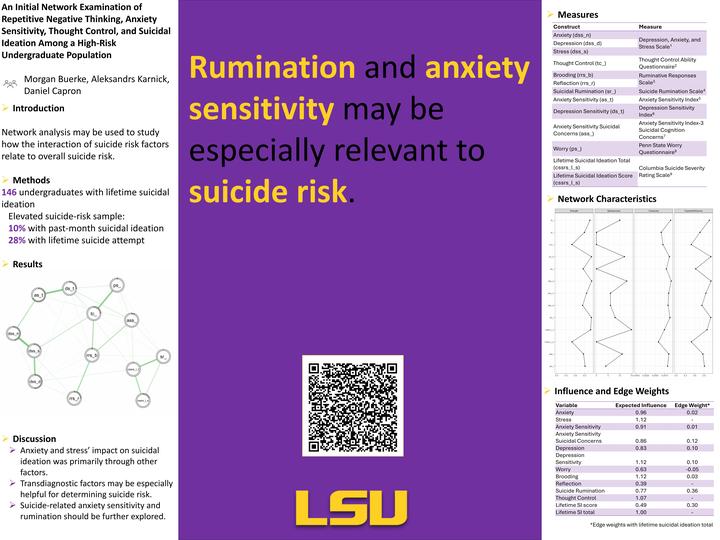An Initial Network Examination of Repetitive Negative Thinking, Anxiety Sensitivity, Thought Control, and Suicidal Ideation Among a High-Risk Undergraduate Population

Abstract
Our understanding of suicide has been largely limited by an examining single risk factors, rather than the interaction and integration of how multiple risk factors come together to make up an individual’s suicide risk. Our current study used a network analytic approach to examine how certain risk factors, namely repetitive negative thinking (i.e., brooding, reflection, worry, anger rumination, and suicidal rumination), anxiety sensitivity and related constructs (i.e., anxiety sensitivity, depressive sensitivity, and anxiety sensitivity suicidal cognitive concerns), thought control, and psychopathology (i.e., depression, anxiety, and stress) may interact in relation to a person’s lifetime suicidal ideation. The advantage of this approach is the ability to see how variables interact with each other and which relate to suicidal ideation directly, vs. indirectly. Our sample included 146 undergraduates with lifetime suicidal ideation from a Southern University (M Age: 22.7; 66%Female; 76% White; 60% Heterosexual). All analyses were conducted using the packages mgm and bootnet in R Version 4.3.1. Scores on measures assessing the above subtests were first scaled. We used a least absolute shrinkage and selection operator to regularize the network and estimated betweenness, closeness, strength, expected influence, and edge-weight between variables. Stability of the network was examined using bootstrapping at 1000 iterations and estimates indicated that the strength and expected Influence were stable (CS-coefficients: 0.435 for each). Stress (Expected Influence [EI]: 1.12), Brooding (EI: 1.12), Depression sensitivity (EI: 1.12), Thought Control (EI: 1.07), and lifetime suicidal ideation (EI: 1.00) were the mosti nfluential variables in the network. Anxiety and stress levels did not directly relate to suicidal ideation, instead their influence was through variables such as anxiety and depression sensitivity, thought control, brooding, worry, and anxiety-sensitivity cognitive concerns. Lifetime suicidal ideation has a direct relationship with depression (Edge Weight [EW]: 0.10), as well as brooding (EW: 0.03), depression sensitivity[EW: 0.10], and suicide-related variables (i.e., suicidal rumination [EW: 0.36], anxiety sensitivity suicidal cognitive concerns [0.12]). Interestingly, worry had a direct, but negative relationship with lifetime suicidal ideation [EW: -0.05]. These results indicate the need to continue examining the role of transdiagnostic variables in suicide risk, and give additional evidence that suicide likely rises from a combination of multiple transdiagnostic risk factors, rather than any one form of psychopathology.